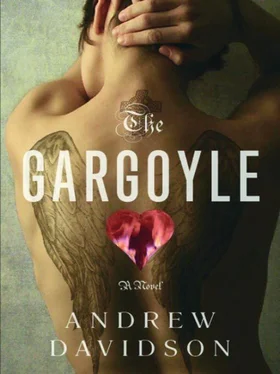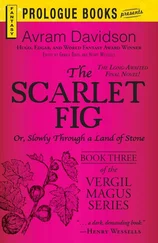“No worries,” Sayuri said. “I love Christmas shopping.”
Hearing this, Gregor also quickly agreed. I gave each an envelope that included what I wanted them to buy, on my behalf, for the other. As they left the room Gregor glanced back at me, a strange little smile on his face.
· · ·
Marianne Engel had not yet finished reading Inferno to me. In part, it was going so slowly because she never read too much in a single sitting, preferring to savor the beauty of the writing, but also because she kept slipping into Italian. I never had the heart to stop her when she did this because she was so deep into the story and, besides, the Italian sounded wonderful from her mouth. At the end of the canto, I would have to point out that I had understood nothing, and the next day she would repeat the section, usually making it all the way through in English.
Voltaire wrote that Dante was a madman who had many commentators, and whose reputation would continue to grow mostly because almost no one actually reads the Commedia. I suggest the reason that so few people read Dante is because no one actually needs to. In the Western world, Inferno is everyone’s idea of Hell; as literature, only the Bible is more deeply woven into society’s collective consciousness.
“Did you know,” Marianne Engel asked, “that Dante’s Hell was based upon The Flowing Light of the Godhead, by Mechthild von Magdeburg?”
“One of your Three Masters, right?”
“Yes,” she answered.
I admitted that, not surprisingly, I knew very little (in truth: nothing) about this woman, so Marianne Engel proceeded to educate me. Mechthild was born in Saxony near the start of the thirteenth century and as a child experienced daily visits from no less a figure than the Holy Ghost itself. At twenty she became a Beguine at Magdeburg, living a dutiful life of prayer and mortification; interestingly, as she increased the severity of her self-punishment, her visions became correspondingly more frequent. When she described them to her confessor, he became certain of their divine origins and impelled Mechthild to write them down.
Das flieЯende Licht der Gottheit, as the masterwork is known in German, influenced countless writers who followed, including Meister Eckhart and Christina Ebner. It is also clear that Dante Alighieri read the Latin translation, and many scholars are convinced he used Mechthild’s ordering of the afterlife as the conceptual basis for the Divine Comedy: Heaven at the top, Purgatory directly below, and Hell at the bottom. In the very abyss of Mechthild’s Hell, Satan is chained by his own sins while anguish, plague, and ruin flow from his burning heart and mouth. This sounds suspiciously similar to Dante’s Satan, a three-faced beast trapped in a block of ice at the lowest center of Hell chewing at a frothy trio of sinners (Judas, Cassius, and Brutus) whose pus flows from his three mouths for all eternity.
“There are those who believe,” said Marianne Engel, “that the ‘Matilda’ Dante encounters in Purgatorio is in fact Mechthild.”
“Is that what you think?” I asked.
“I believe,” she answered with a slight smile, “that in his work, Dante often wrote in appearances by those who influenced him.”
As she read me the tale of Dante’s journey, I found it deeply familiar and I loved it despite (or perhaps because of?) my burn ward surroundings. There was something comforting in having Marianne Engel read it to me, and in the way she curled her fingers into mine as she did. I marveled at the twisting mix of our glorious and ghastly hands, and I wanted her reading of the story to never end-perhaps because I was afraid that when it did, she would no longer continue to lead me, hand in hand, though my own Hell.
When I presented Marianne Engel my theory that no one needs to read Inferno to know its representation of Hell, she was quick to correct me. “While that may be true for most people, you know it so well because I read you my German translation.”
“Uh-huh.” I hadn’t seen that coming. “When did you translate it?”
“I suppose about ten or twenty years after Dante finished writing it. It took me quite a while. I’m pretty sure I was Inferno ’s first translator, but you can never be positive about these things.”
“And when did you read it to me?” I asked.
“When you were recovering from your first burn.”
· · ·
Inferno was first published in A.D. 1314. If Marianne Engel completed her translation twenty years later, the year would have been approximately 1334. Given her earlier claim that she was born in the year 1300, this would put her in her mid-thirties at the time.
As I detail these numbers, I’m not forgetting that this is ludicrous and could not have actually occurred. I’m simply pointing out that, at least, the impossible things were occurring in a possible timeline. This is what I find rather amazing about her mental state: her wild statements were held together by internal consistency.
Because I didn’t live in the Middle Ages, I needed to do a lot of research during the writing of this book to check what she said, or what I remember her saying, against facts. The interesting thing is that all the events she claimed were true could have happened exactly as she described them, had she not been talking about ancient events in the first person.
Despite being under the control of the Church, Engelthal was a democratic institution whose prioress was elected. All daily activities were outlined in the Orders of the Constitution. Marianne Engel’s descriptions of the architecture, the prayers, the books studied, and the rituals for eating were accurate. Christina Ebner was in that monastery and she did write The Sister-book of Engelthal and Revelations. Friedrich Sunder was a local priest, the confessor to the nuns, and he did write Gnaden-vita. There was a book called The Vita of Sister Gertrud of Engelthal, written with the help of a Brother Heinrich and Cunrat Fridrich.
While there is no record of Heinrich Seuse having visited Engelthal, there is also no way to prove that he did not do so. If he did come during the early 1320s, as Marianne Engel claimed, this was when he was traveling from StraЯburg to Kцln to study under Meister Eckhart. So who’s to say he didn’t visit the monastery that was widely regarded as the foremost center of German mysticism?
Still. No matter how perfectly she constructed her timelines or researched German religious figures, Marianne Engel was either schizophrenic or manic depressive, or both. I cannot forget this. Creating and managing imaginary universes is the province of such people: it’s not only what they do, it’s who they are. And there were some seeming discrepancies in Marianne Engel’s account; for example, there is no record of a Sister Marianne in any of the extant writings from Engelthal, nor is there any mention of Die Gertrud Bibel, and I tried to use these omissions to force Marianne Engel into admitting her story was not true.
“You are studious, aren’t you?” she said. “Don’t worry, there’s a reason you can’t find information on me or on Gertrud’s Bible. We’ll get to it, I promise.”
· · ·
Goodwill carolers dropped in to sing about silent nights, holy nights. A Sally Ann Santa brought cookies and books. Decorations went up along the hallways.
How strange it was to be looking forward to the holiday season. Traditionally, I’d hated Christmas; it always left a taste in my mouth akin to moldy fruitcake. (By this, I do not mean an elderly Japanese spinster.) In my childhood, I’d had a succession of Christmases when the Graces spent the money originally intended for my presents on methamphetamine; in my adulthood, Christmas meant fucking a woman who was wearing a red felt hat.
Читать дальше











